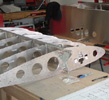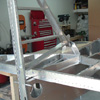


random user submitted photo
3300 Engine question
11 posts
• Page 2 of 2 • 1, 2
Re: 3300 Engine question
For the TCM Continental engines, low compression is only an indicator, however, any leakage past an exhaust valve must be corrected. Leakage past piston rings is not necessarily unairworthy. We have found that engines that have not been operated for a period time may have low compression due to corrosion on the cylinder walls, and this can often be corrected by flying at high (at least 75%) power settings, which pushes the piston rings against the cylinder walls and tends to scrape the corrosion off the cylinder walls and restore compression. I am personally aware of two engines that were not run for over two years, which had low compression, that were flown a few hours at high manifold pressures (easier with a constant speed propeller) and normal compression was restored. Food for thought on this situation. This process cannot be guaranteed to restore compression but is certainly worth a try, for an engine that has not been run for a period of time and has low compression. This is also why new or newly overhauled engines are broken in by flying with high power settings, to force the piston rings onto the cylinder walls and scrape off the roughness. A new TCM engine is broken in when the oil consumption goes to normal, took two only hours of flying at high power settings on my last overhaul and on my last factory remanufactured engine. (TCM IO-470-N engines)
- N190YX
- Posts: 80
- Joined: Thu Jun 26, 2014 7:01 pm
11 posts
• Page 2 of 2 • 1, 2
Who is online
Users browsing this forum: No registered users and 26 guests







